An early example of the Spaghetti Western is Buffalo Bill, l'eroe del far west/Buffalo Bill, Hero of the Far West (Mario Costa, 1964). It was the Western debut of Gordon Scott, former Tarzan and hero of several Peplums. The muscular American starred as the legendary frontier scout and showman of the title. The film was a co-production of Italy, France and West Germany, which explains perhaps why the collectors cards in this post are German.
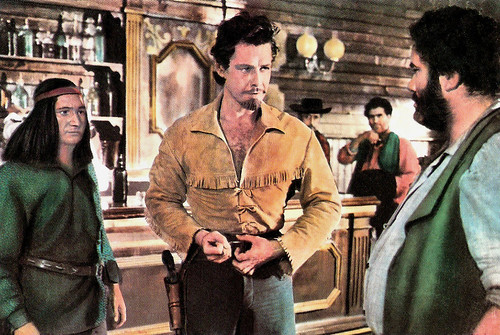
German collectors card by J & M Serienbilder Produktion Saar, no. 35. Photo: Gloria Film. Publicity still for Buffalo Bill, l'eroe del far west/Buffalo Bill, Hero of the Far West (Mario Costa, 1965) with Gordon Douglas. Caption: "Buffalo Bill, der Held des Wilden Westens ohne Furcht und Tadel, fürchtete selbst die gefährlichtsen Gegner nicht. Er ist entschlossen den illegalen Waffenhändlern das Handwerk zu legen." (Buffalo Bill, the hero of the Wild West without fear and without reproach, did not fear even the most dangerous opponent. He is determined to put down the business of the illegal arms dealers.)
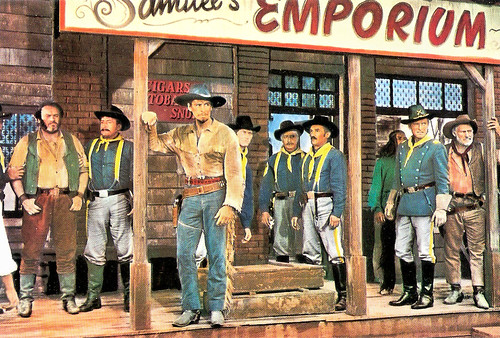
German collectors card by J & M Serienbilder Produktion Saar, no. 46. Photo: Gloria Film. Publicity still for Buffalo Bill, l'eroe del far west/Buffalo Bill, Hero of the Far West (Mario Costa, 1965). Caption: "Der erste Schurke, Big Sam, ist gefasst. Buffalo Bill hat bei ihm die Schiesseisen für die Rothäute gefunden. Big Sam gehört zu den Banditen, auf deren Konto die neunen Kämpfe zwischen Sioux und Weissen kommen." (The first villain, Big Sam is taken. Buffalo Bill has found at his place the firearms for the Redskins. Big Sam is one of the bandits, on whose account comes the new fighting between Sioux and whites.)
Buffalo Bill, l'eroe del Far West (1965) was not only the first Western of Gordon Scott, but also of veteran director Mario Costa. Costa, who had directed Scott in the Peplum Il gladiatore di Roma/Gladiator of Rome (1962), took the name of John Fordson. But the son of John Ford, the Italian was not exactly. Buffalo Bill would turn out to be his only Western.
There have been countless films and TV-films about Buffalo Bill, including Buffalo Bill (William A. Wellman, 1944) featuring Joel McCrea, Pony Express (Jerry Hopper, 1953) with Charlton Heston, and Buffalo Bill and the Indians, or Sitting Bull's History Lesson (Robert Altman, 1976) starring Paul Newman.
The real Buffalo Bill was William Frederick Cody (1846-1917), an American scout, bison hunter, and showman. During the American Civil War, he served for the Union from 1863 to the end of the war in 1865. Later he served as a civilian scout to the US Army during the Indian Wars, receiving the Medal of Honor in 1872. One of the most colorful figures of the American Old West, Buffalo Bill started performing in shows that displayed cowboy themes and episodes from the frontier and Indian Wars. He founded his Buffalo Bill's Wild West in 1883, taking his large company on tours.
Buffalo Bill’s Wild West toured Europe eight times, the first four tours between 1887 and 1892, and the last four from 1902 to 1906. In 1890 Cody met Pope Leo XIII, and that year, a competition took place in Italy. Buffalo Bill had met some of the Italian 'butteri' (Italian cowboys) and said his men were more skilled at roping calves and performing other similar actions. A group of Buffalo Bill's men challenged nine butteri, led by Augusto Imperiali in Rome. The Italian butteri easily won the competition and Augusto Imperiali became a sort of local hero after the event.
In the film Colonel William Cody, alias Buffalo Bill (Gordon Scott), intends to put an end to the dishonest relations between a gang of white swindlers and the Indian, Yellow Hand (Mirko Ellis). So he goes to the chief of Yellow Hand's tribe, White Fox (Feodor Chaliapin Jr.), and tries to convince him to sign a peace treaty with the Federal troops. In order to avoid this, the gun runners abduct White Fox's daughter, Silver Moon Ray (Catherine Ribeiro), attempting to put the blame on the soldiers of Colonel Peterson (Roldano Lupi).
The big showdown at the end of the film takes place in a cavalry fort with the Indians scaling the walls and gives Buffalo Bill a run for his money. It was all spectacularly filmed by Massimo Dallamano, who also was the cinematographer for Per un pugno di dollari/A Fistful of Dollars (Sergio Leone, 1964).
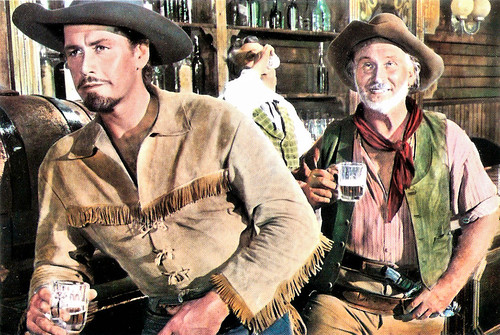
German collectors card by J & M Serienbilder Produktion Saar, no. 48. Photo: Gloria Film. Publicity still for Buffalo Bill, l'eroe del far west/Buffalo Bill, Hero of the Far West (Mario Costa, 1965). Caption: "Buffalo Bill kennt keinen Pardon für Bösewichte. Viele Gefahren haben den gerechten Indianerfreund hart gemacht. Das schwerste Abenteur steht den edlen Kämpfer noch bevor." (Buffalo Bill knows no mercy for the bad guys. Many threats have made the fair Indians friend hard. His hardest adventure is still to come for the noble fighter.)
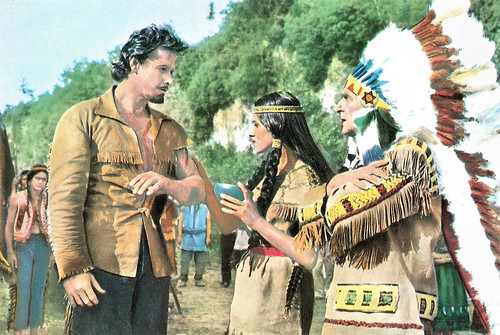
German collectors card by J & M Serienbilder Produktion Saar, no. 49. Photo: Gloria Film. Publicity still for Buffalo Bill, l'eroe del far west/Buffalo Bill, Hero of the Far West (Mario Costa, 1965) with Gordon Scott, Catherine Ribeiro and Feodor Chaliapin Jr. Caption: "Auch die schöne Tochter 'Mondstrahl' des Häuptlings 'Weisser Fuchs' ist Buffalo Bill, dem berühmten tapferen Mann der Weissen, zugetan. Sie versorgt seine Verwundung aus dem Kampf gegen den Sioux 'Gelbe Hand'." (The beautiful daughter 'Moonbeam' of chief 'White Fox' is devoted to Buffalo Bill, the famous brave man of the white. She cares for his wounds from the fight against the Sioux 'Yellow Hand'.)
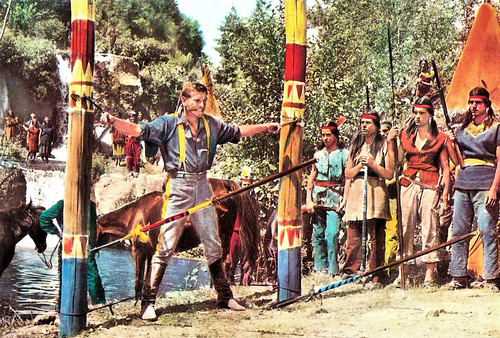
German collectors card by J & M Serienbilder Produktion Saar, no. 55. Photo: Gloria Film. Publicity still for Buffalo Bill, l'eroe del far west/Buffalo Bill, Hero of the Far West (Mario Costa, 1965). Caption: "Captain Hunter zerrt verzweifelt an den Fesseln. Der mutige Freund Buffalo Bills muss zusehen, wie im Lager der skalpgierigen Sioux-Krieger die Tochter seines Colonels gemartert werden soll." (Captain Hunter drags desperately at the chains. The courageous friend of Buffalo Bill must watch how the daughter of his colonel will be martyred in the camp of the scalp greedy Sioux Warriors.)
Although I called Buffalo Bill, l'eroe del Far West/Buffalo Bill, Hero Of The West in the lead of this post a Spaghetti Western, it isn't quite like what you usually associate with this genre. Most of the pre-Sergio Leone Westerns made in Italy resemble conventional Hollywood horse operas. Reviewer Wizard-8 at IMDb: "The movie plays out like it was made by American filmmakers, from the standard western plot right down to the musical score."
The basic premise of Buffalo Bill, l'eroe del Far West also seems to be inspired by the Karl May films, like Der Schatz im Silbersee/Treasure of Silver Lake (Harald Reinl, 1963) and Winnetou - 1. Teil/Apache Gold (Harald Reinl, 1963), that precipitated the Spaghetti Western boom.
Another reviewer at IMDb, Steve Nyland, is positive about the casting of Gordon Scott as Buffalo Bill Cody: "Gordon Scott is well cast & appropriately larger than life as the Indian fighter turned US Army scout Buffalo Bill Cody, trading in his Samson tunic for a buckskin jacket + goatee. (...). And he plays Cody pretty much as he played the Son of Hercules: Strapping, brawny, beefy, but surprisingly intelligent, insightful, and considerate of even the guy whom he beats the stuffing out of in a bar room brawl. He is almost insufferably good, working for the native Indians to live side by side with his fellow Palefaces and keep the two sides from massacring each other."
Scott as Buffalo Bill is not working for himself to obtain vast sums of money like the bounty hunters in later Spaghetti Westerns. Instead, he is on a mission of mercy authorized by the President to root out injustice.
Steve Nyland: "The spaghetti genre itself had also changed by the time this film was circulating, with the more stylish approaches of DJANGO and Sergio Leone's 'Dollar' films making the more traditionalist approach seen here look a bit old fashioned by comparison. And that's exactly why I adore it: Here's a spaghetti western from the infancy of the genre when they were still making movies about good guys & bad guys, Injuns and the cavalry, and a do-gooder hero designed to be rooted for like he was Audie Murphy or something. The change of pace is quite refreshing."
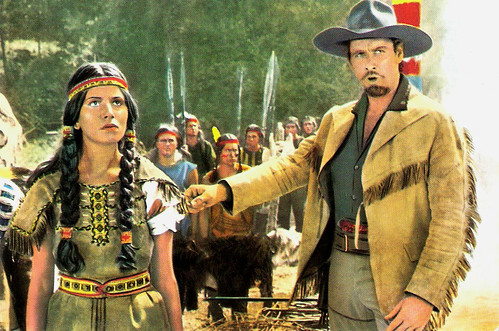
German collectors card by J & M Serienbilder Produktion Saar, no. 59. Photo: Gloria Film. Publicity still for Buffalo Bill, l'eroe del far west/Buffalo Bill, Hero of the Far West (Mario Costa, 1965). Caption: "Der erfolglose Angriff des Häuptlings 'Gelbe Hand' aus Fort Adam galt auch der Tochter des grossen Indianenführers 'Weiser Fuchs'. Ihre Verletzung stammt aus einem erbitterten Nahkampf, in den Buffalo Bill tollkühn eingegriffen hat." (The unsuccessful attack of the chief 'Yellow Hand' from Fort Adam applied also the daughter of the great Indian leader 'White Fox'. Her injury is from a fierce close combat, in which Buffalo Bill has intervened foolhardy.)
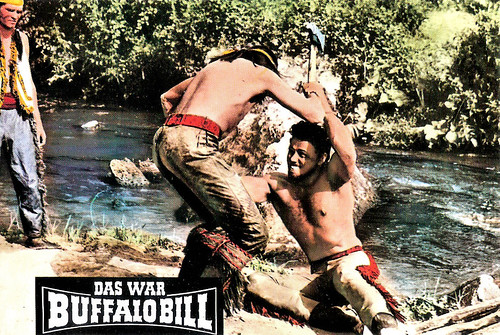
German collectors card by J & M Serienbilder Produktion Saar, no. 67. Photo: Gloria Film. Publicity still for Buffalo Bill, l'eroe del far west/Buffalo Bill, Hero of the Far West (Mario Costa, 1965) with Mirko Ellis and Gordon Scott (at right). Caption: "Wieder beweist der feige Häuptling Gelbe Hand'' im atemberaubenden Zweikampf mit Buffalo Bill seine Heimtücke. Er schmettert den Tomahawk auf den waffenlosen Gegner und deshalb verachten ihn jetzt sogar die eigenen Stammesgenossen." (Again the cowardly chief Yellow Hand hows his maliciousness in a breathtaking duel with Buffalo Bill. He smashes the Tomahawk on his unarmed opponent and therefore even his own tribesmen now despise him.)
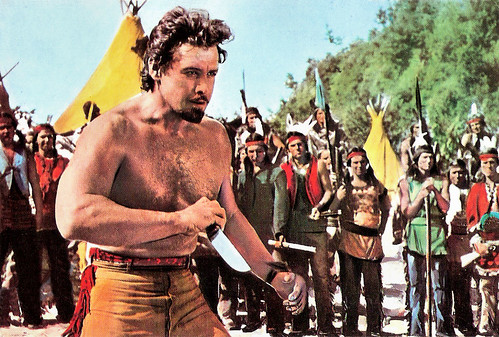
German collectors card by J & M Serienbilder Produktion Saar, no. 68. Photo: Gloria Film. Publicity still for Buffalo Bill, l'eroe del far west/Buffalo Bill, Hero of the Far West (Mario Costa, 1965). Caption: "In einem Zweikampf auf Leben und Tod hat Buffalo Bill, der berühmteste Held des Wilden Westens, seinen gefährlichsten Feind bezwungen. Der edle Kämpfer schenkt seinem Gegner das Leben. Die Indianer selbst sollen seine Strafe bestimmen." (In a duel to death, Buffalo Bill, the famous hero of the Wild West, has defeated his most dangerous enemy. The noble warrior gives his opponent his life. The Indians themselves have to determine his punishment.)
Sources: Steve Nyland (IMDb), Wikipedia, IMDb and The Spaghetti Western Database.

German collectors card by J & M Serienbilder Produktion Saar, no. 35. Photo: Gloria Film. Publicity still for Buffalo Bill, l'eroe del far west/Buffalo Bill, Hero of the Far West (Mario Costa, 1965) with Gordon Douglas. Caption: "Buffalo Bill, der Held des Wilden Westens ohne Furcht und Tadel, fürchtete selbst die gefährlichtsen Gegner nicht. Er ist entschlossen den illegalen Waffenhändlern das Handwerk zu legen." (Buffalo Bill, the hero of the Wild West without fear and without reproach, did not fear even the most dangerous opponent. He is determined to put down the business of the illegal arms dealers.)

German collectors card by J & M Serienbilder Produktion Saar, no. 46. Photo: Gloria Film. Publicity still for Buffalo Bill, l'eroe del far west/Buffalo Bill, Hero of the Far West (Mario Costa, 1965). Caption: "Der erste Schurke, Big Sam, ist gefasst. Buffalo Bill hat bei ihm die Schiesseisen für die Rothäute gefunden. Big Sam gehört zu den Banditen, auf deren Konto die neunen Kämpfe zwischen Sioux und Weissen kommen." (The first villain, Big Sam is taken. Buffalo Bill has found at his place the firearms for the Redskins. Big Sam is one of the bandits, on whose account comes the new fighting between Sioux and whites.)
Buffalo Bill's Wild West
Buffalo Bill, l'eroe del Far West (1965) was not only the first Western of Gordon Scott, but also of veteran director Mario Costa. Costa, who had directed Scott in the Peplum Il gladiatore di Roma/Gladiator of Rome (1962), took the name of John Fordson. But the son of John Ford, the Italian was not exactly. Buffalo Bill would turn out to be his only Western.
There have been countless films and TV-films about Buffalo Bill, including Buffalo Bill (William A. Wellman, 1944) featuring Joel McCrea, Pony Express (Jerry Hopper, 1953) with Charlton Heston, and Buffalo Bill and the Indians, or Sitting Bull's History Lesson (Robert Altman, 1976) starring Paul Newman.
The real Buffalo Bill was William Frederick Cody (1846-1917), an American scout, bison hunter, and showman. During the American Civil War, he served for the Union from 1863 to the end of the war in 1865. Later he served as a civilian scout to the US Army during the Indian Wars, receiving the Medal of Honor in 1872. One of the most colorful figures of the American Old West, Buffalo Bill started performing in shows that displayed cowboy themes and episodes from the frontier and Indian Wars. He founded his Buffalo Bill's Wild West in 1883, taking his large company on tours.
Buffalo Bill’s Wild West toured Europe eight times, the first four tours between 1887 and 1892, and the last four from 1902 to 1906. In 1890 Cody met Pope Leo XIII, and that year, a competition took place in Italy. Buffalo Bill had met some of the Italian 'butteri' (Italian cowboys) and said his men were more skilled at roping calves and performing other similar actions. A group of Buffalo Bill's men challenged nine butteri, led by Augusto Imperiali in Rome. The Italian butteri easily won the competition and Augusto Imperiali became a sort of local hero after the event.
In the film Colonel William Cody, alias Buffalo Bill (Gordon Scott), intends to put an end to the dishonest relations between a gang of white swindlers and the Indian, Yellow Hand (Mirko Ellis). So he goes to the chief of Yellow Hand's tribe, White Fox (Feodor Chaliapin Jr.), and tries to convince him to sign a peace treaty with the Federal troops. In order to avoid this, the gun runners abduct White Fox's daughter, Silver Moon Ray (Catherine Ribeiro), attempting to put the blame on the soldiers of Colonel Peterson (Roldano Lupi).
The big showdown at the end of the film takes place in a cavalry fort with the Indians scaling the walls and gives Buffalo Bill a run for his money. It was all spectacularly filmed by Massimo Dallamano, who also was the cinematographer for Per un pugno di dollari/A Fistful of Dollars (Sergio Leone, 1964).

German collectors card by J & M Serienbilder Produktion Saar, no. 48. Photo: Gloria Film. Publicity still for Buffalo Bill, l'eroe del far west/Buffalo Bill, Hero of the Far West (Mario Costa, 1965). Caption: "Buffalo Bill kennt keinen Pardon für Bösewichte. Viele Gefahren haben den gerechten Indianerfreund hart gemacht. Das schwerste Abenteur steht den edlen Kämpfer noch bevor." (Buffalo Bill knows no mercy for the bad guys. Many threats have made the fair Indians friend hard. His hardest adventure is still to come for the noble fighter.)

German collectors card by J & M Serienbilder Produktion Saar, no. 49. Photo: Gloria Film. Publicity still for Buffalo Bill, l'eroe del far west/Buffalo Bill, Hero of the Far West (Mario Costa, 1965) with Gordon Scott, Catherine Ribeiro and Feodor Chaliapin Jr. Caption: "Auch die schöne Tochter 'Mondstrahl' des Häuptlings 'Weisser Fuchs' ist Buffalo Bill, dem berühmten tapferen Mann der Weissen, zugetan. Sie versorgt seine Verwundung aus dem Kampf gegen den Sioux 'Gelbe Hand'." (The beautiful daughter 'Moonbeam' of chief 'White Fox' is devoted to Buffalo Bill, the famous brave man of the white. She cares for his wounds from the fight against the Sioux 'Yellow Hand'.)

German collectors card by J & M Serienbilder Produktion Saar, no. 55. Photo: Gloria Film. Publicity still for Buffalo Bill, l'eroe del far west/Buffalo Bill, Hero of the Far West (Mario Costa, 1965). Caption: "Captain Hunter zerrt verzweifelt an den Fesseln. Der mutige Freund Buffalo Bills muss zusehen, wie im Lager der skalpgierigen Sioux-Krieger die Tochter seines Colonels gemartert werden soll." (Captain Hunter drags desperately at the chains. The courageous friend of Buffalo Bill must watch how the daughter of his colonel will be martyred in the camp of the scalp greedy Sioux Warriors.)
Adorable old-fashioned
Although I called Buffalo Bill, l'eroe del Far West/Buffalo Bill, Hero Of The West in the lead of this post a Spaghetti Western, it isn't quite like what you usually associate with this genre. Most of the pre-Sergio Leone Westerns made in Italy resemble conventional Hollywood horse operas. Reviewer Wizard-8 at IMDb: "The movie plays out like it was made by American filmmakers, from the standard western plot right down to the musical score."
The basic premise of Buffalo Bill, l'eroe del Far West also seems to be inspired by the Karl May films, like Der Schatz im Silbersee/Treasure of Silver Lake (Harald Reinl, 1963) and Winnetou - 1. Teil/Apache Gold (Harald Reinl, 1963), that precipitated the Spaghetti Western boom.
Another reviewer at IMDb, Steve Nyland, is positive about the casting of Gordon Scott as Buffalo Bill Cody: "Gordon Scott is well cast & appropriately larger than life as the Indian fighter turned US Army scout Buffalo Bill Cody, trading in his Samson tunic for a buckskin jacket + goatee. (...). And he plays Cody pretty much as he played the Son of Hercules: Strapping, brawny, beefy, but surprisingly intelligent, insightful, and considerate of even the guy whom he beats the stuffing out of in a bar room brawl. He is almost insufferably good, working for the native Indians to live side by side with his fellow Palefaces and keep the two sides from massacring each other."
Scott as Buffalo Bill is not working for himself to obtain vast sums of money like the bounty hunters in later Spaghetti Westerns. Instead, he is on a mission of mercy authorized by the President to root out injustice.
Steve Nyland: "The spaghetti genre itself had also changed by the time this film was circulating, with the more stylish approaches of DJANGO and Sergio Leone's 'Dollar' films making the more traditionalist approach seen here look a bit old fashioned by comparison. And that's exactly why I adore it: Here's a spaghetti western from the infancy of the genre when they were still making movies about good guys & bad guys, Injuns and the cavalry, and a do-gooder hero designed to be rooted for like he was Audie Murphy or something. The change of pace is quite refreshing."

German collectors card by J & M Serienbilder Produktion Saar, no. 59. Photo: Gloria Film. Publicity still for Buffalo Bill, l'eroe del far west/Buffalo Bill, Hero of the Far West (Mario Costa, 1965). Caption: "Der erfolglose Angriff des Häuptlings 'Gelbe Hand' aus Fort Adam galt auch der Tochter des grossen Indianenführers 'Weiser Fuchs'. Ihre Verletzung stammt aus einem erbitterten Nahkampf, in den Buffalo Bill tollkühn eingegriffen hat." (The unsuccessful attack of the chief 'Yellow Hand' from Fort Adam applied also the daughter of the great Indian leader 'White Fox'. Her injury is from a fierce close combat, in which Buffalo Bill has intervened foolhardy.)

German collectors card by J & M Serienbilder Produktion Saar, no. 67. Photo: Gloria Film. Publicity still for Buffalo Bill, l'eroe del far west/Buffalo Bill, Hero of the Far West (Mario Costa, 1965) with Mirko Ellis and Gordon Scott (at right). Caption: "Wieder beweist der feige Häuptling Gelbe Hand'' im atemberaubenden Zweikampf mit Buffalo Bill seine Heimtücke. Er schmettert den Tomahawk auf den waffenlosen Gegner und deshalb verachten ihn jetzt sogar die eigenen Stammesgenossen." (Again the cowardly chief Yellow Hand hows his maliciousness in a breathtaking duel with Buffalo Bill. He smashes the Tomahawk on his unarmed opponent and therefore even his own tribesmen now despise him.)

German collectors card by J & M Serienbilder Produktion Saar, no. 68. Photo: Gloria Film. Publicity still for Buffalo Bill, l'eroe del far west/Buffalo Bill, Hero of the Far West (Mario Costa, 1965). Caption: "In einem Zweikampf auf Leben und Tod hat Buffalo Bill, der berühmteste Held des Wilden Westens, seinen gefährlichsten Feind bezwungen. Der edle Kämpfer schenkt seinem Gegner das Leben. Die Indianer selbst sollen seine Strafe bestimmen." (In a duel to death, Buffalo Bill, the famous hero of the Wild West, has defeated his most dangerous enemy. The noble warrior gives his opponent his life. The Indians themselves have to determine his punishment.)
Sources: Steve Nyland (IMDb), Wikipedia, IMDb and The Spaghetti Western Database.
No comments:
Post a Comment